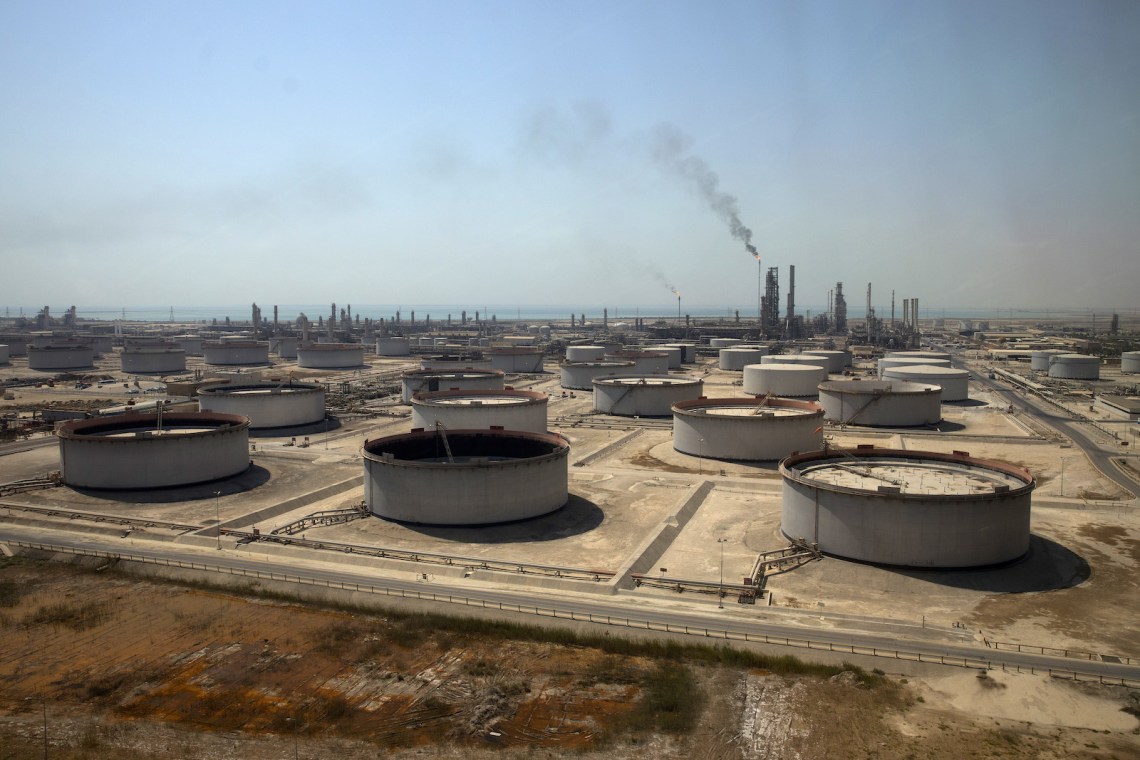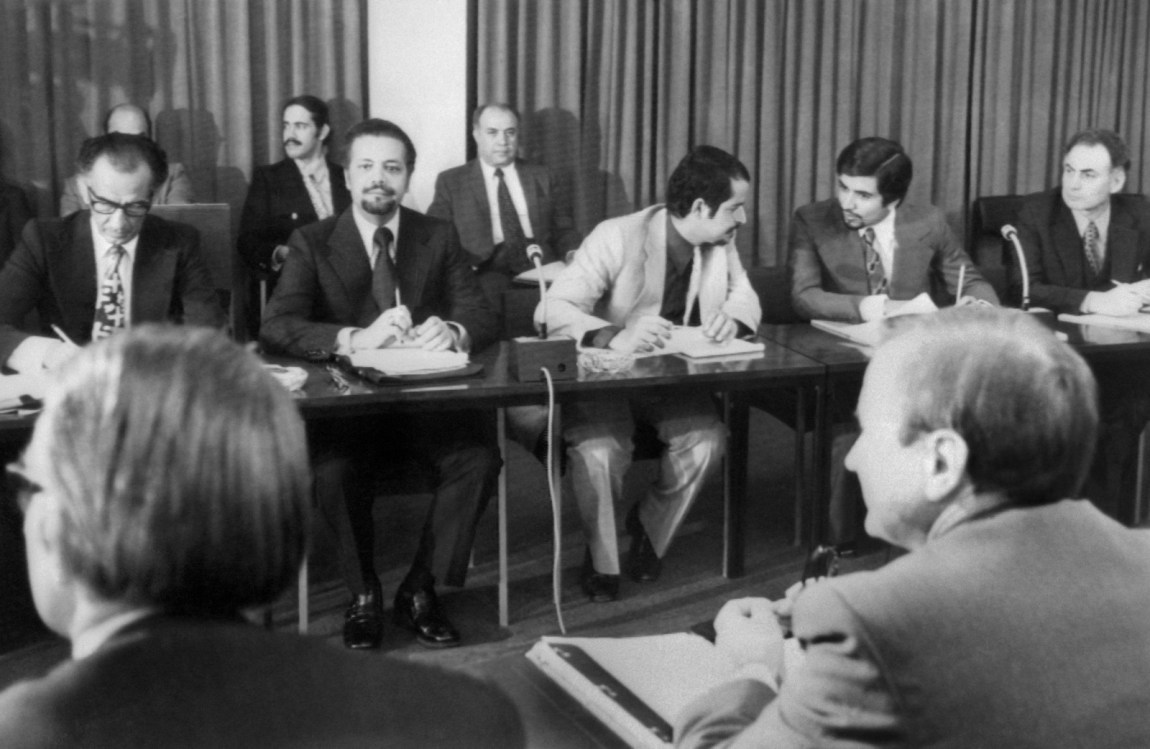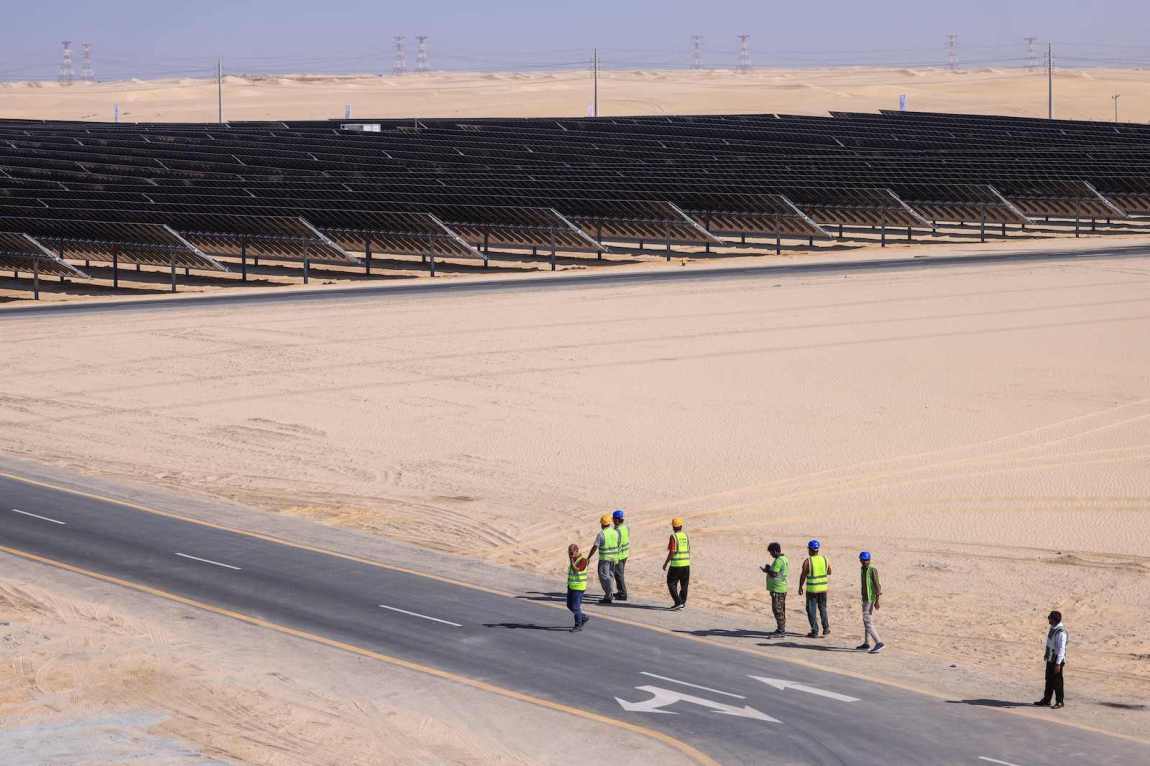Last December’s UN climate talks (COP 28), held in the UAE, had an unlikely president: Sultan Al Jaber, who for eight years has headed the country’s state-owned oil company. Under his leadership, the Abu Dhabi National Oil Company (ADNOC) has emerged as the world’s eleventh largest oil firm, producing over a billion barrels in 2021. ADNOC plans to invest at least $150 billion in the coming four years on fossil fuel expansion, which Jaber has pledged to keep going over at least two decades. By 2050 it is projected to be the world’s second-largest producer, after Saudi Arabia’s NOC Aramco, with an output nearly 50 percent above that of Shell, BP, and TotalEnergies combined. And yet the UN thought it fitting for ADNOC’s president to oversee an agreement on policies aimed at checking any further rise in global temperatures.
In recent years Gulf National Oil Companies (NOCs) have taken an increasingly prominent part in global climate policy. These firms also loomed large over COP27, convened in Egypt in 2022. There, the Gulf monarchies blocked language about phasing out fossil fuel use—and indeed any mention of oil at all—from the final communique. Their outsized power was reflected in the physical arrangement of the venue: the national pavilion of Saudi Arabia, by far the largest, measured 1,008 square meters, twice that of the pavilion housing the entire continent of Africa. Gulf states had the next three largest pavilions. Much the same can expected at COP29, to be convened next year in Azerbaijan, another oil-rich state with close ties to the Gulf.
The presence of fossil fuels executives at COP is itself hardly surprising. Oil companies the world over are rebranding themselves as part of the solution to the climate crisis, with high-profile announcements about their commitment to sustainability, emissions reductions, and green energy investment. A record 2,400 delegates connected to the industry attended COP28, four times as many as at COP27, and more than the total number of representatives from the ten countries most vulnerable to climate change. Yet it is particularly hypocritical for the heads of Gulf NOCs to stake a claim on the green transition. Far from addressing the climate crisis, they plan to accelerate fossil fuel production at an unprecedented rate—flatly ignoring the scientific consensus that further exploration will push global temperature increases past the 1.5 degrees Celsius benchmark set in 2015 at COP21 in Paris.
Saudi Aramco leads the way. With a market capitalization of over $2 trillion, it is in the middle of its largest capital expenditure program ever—double that of Europe’s biggest oil company, Shell. According to the Saudi energy minister, Abdulaziz bin Salman Al Saud, the aim is to ensure that “every molecule of hydrocarbon will come out.” The heads of other expanding NOCs, like ADNOC, Kuwait Petroleum Corporation, and QatarEnergy, no doubt agree. That these firms are also investing in unproven “low carbon technologies” like hydrogen and carbon capture as well as in wind and solar energy should not distract from their main line of business.

Christopher Pike/COP28/Flickr
Sultan Al Jaber at the UN Climate Conference (COP28), Dubai, United Arab Emirates, December 2023
Climate activists in the west tend to focus on the traditional “supermajors” like BP, Shell, and ExxonMobil. Those firms are still extremely powerful and destructive, especially in North America and Western Europe. But the oil industry has fragmented along regional lines, and in recent decades its center has shifted toward the Middle East. A perspective on the climate crisis that ignores this development is fundamentally out of step with reality.
*
For much of the twentieth century, the world’s oil supply was controlled by seven American and European companies, known as the “Seven Sisters”: Anglo-Iranian Oil Company (now BP); Royal Dutch Shell; Standard Oil Company of California (now part of Chevron); Gulf Oil (now part of Chevron); Texaco (now part of Chevron); Standard Oil Company of New Jersey (now part of ExxonMobil); and the Standard Oil Company of New York (now part of ExxonMobil). These firms were marked by an extremely high degree of vertical integration: in addition to owning “upstream” reserves of crude oil, they also managed the “downstream” refining of that oil into fuels and the petrochemicals that form the building blocks of materials such as plastics, synthetic rubber, and fertilizers. They transported and sold their own products as well.
The Seven Sisters were responsible for much of the world’s oil infrastructure. In 1952 an American government investigation estimated that they owned almost all pipelines, refineries, and petrochemical plants outside the US and USSR, and around two-thirds of private tanker fleets. Their access to crude was more varied. In the US, the Seven Sisters competed against an established domestic industry that included many smaller companies. In much of the Middle East and Latin America, however, they held extremely favorable oil concessions, for which they gave royalties and tax payments to autocratic regimes like those in Venezuela, Iran, and Saudi Arabia, based on the oil’s so-called posted price, against which the tax cut of host governments was calculated. Up until the early 1970s, the Seven Sisters used cartel-like arrangements to fix this posted price, set production levels, and deny would-be rivals access to infrastructure.
Advertisement
The hegemony of the Seven Sisters began to falter in the decades after World War II. This was partly because upstart American and European firms were starting to offer better concessionary arrangements to oil-rich governments. But a more significant challenge was posed by the rise of anticolonial and radical movements, many of which called for oil to be nationalized. An early example was Iran, where on May 1, 1951, a few days after his confirmation as Prime Minister, Mohammad Mossadegh passed a law that effectively nationalized the assets of the Anglo-Iranian Oil Company (AIOC). In response, the Seven Sisters launched a boycott of Iranian oil exports by cutting off the country’s access to shipping transport. As this measure took hold, in 1953 a British and American-backed coup ousted Mossadegh. The Pahlavi monarchy returned to power, restored AIOC, and remained a loyal Western ally until it was overthrown in the 1979 Iranian revolution.
In 1955 twenty-nine newly independent governments from Asia and Africa gathered for the Bandung Conference in Indonesia, at which they discussed ways to further “Third World” cooperation. Their final statement exhorted governments to seek “exchange of information on matters relating to oil, such as remittance of profits and taxation, [that] might eventually lead to the formulation of common policies.” The Third Committee of the UN General Assembly adopted a resolution the same year stating that “all peoples have the right to self-determination” and “to freely dispose of their natural wealth and resources.” Opposition only came from the three countries where the Seven Sisters were headquartered: the US, the UK, and the Netherlands.
In 1960 five countries came together to form the Organization of the Petroleum Exporting Countries (OPEC): Iraq, Iran, Saudi Arabia, Kuwait, and Venezuela. Together, they produced around 37 percent of world crude. As Giuliano Garavini points out in his recent history, OPEC was the first international organization led by governments from the Third World, predating the Non-Aligned Movement by a year.1 Yet while a broad Third World solidarity underlay the alliance, it was headed by autocratic regimes that were themselves targets of anti-colonial ire. In the Middle East, for instance, Egyptian president Gamal Abdul Nasser fiercely criticized Saudi Arabia and other Gulf monarchies, calling for their overthrow and demanding that oil wealth be equitably shared across the region. By the early 1970s, however, more radical members—notably Libya, Algeria, Venezuela, and Iraq—had taken decisive steps towards nationalization.
In 1973, as the Seven Sisters refused to increase payments to oil producing states, OPEC took the unilateral decision to raise the posted price. That October, in the midst of the 1973 Arab–Israeli War, some Arab OPEC members enforced an embargo on the US, the Netherlands, and other governments supporting Israel. The two events combined to spike prices for crude and refined oil products, with the cost of oil nearly quadrupling by January 1974. A further shock occurred following oil shortages caused by the 1979 Iranian revolution.
The structure of the global oil industry thereafter changed irrevocably. NOCs established by OPEC members and other states took over the exploration, extraction, and sale of nationalized crude. In 1970 the Seven Sisters and other Western companies had held more than 90 percent of oil reserves outside the US and USSR; a decade later, their share would fall to less than a third. All of this led to a financial windfall for OPEC producers. Between 1965 and 1986, Middle East OPEC members alone would make around $1.7 trillion in oil revenues, of which Saudi Arabia earned over 40 percent. These enormous pools of surplus capital—soon dubbed “petrodollars”—precipitated a historic shift in the global distribution of wealth.
Yet the leading Western firms retained a firm grip over downstream activities, ensuring that they too would benefit from high oil prices. Through the 1980s and 1990s, a wave of corporate restructuring and some of the largest mergers in history led to a new constellation of seven dominant Western firms, known today as “supermajors”: ExxonMobil (US), BP (British), Shell (British/Dutch), Chevron (US), Eni (Italy), TotalEnergies (France), and ConocoPhillips (US).
*
In the 1990s China opened its domestic market to foreign investment, and its manufacturing sector expanded dramatically. The Gulf NOCs and other Middle East countries took the lead in meeting its new and apparently insatiable demand for oil. (Chinese growth is the main reason that the world’s overall consumption of oil is almost 40 percent higher today than it was in 1995.) There was a second petrodollar bonanza as prices rose sharply, urged on by financial speculation in oil futures: from $27 in 2000, the average monthly price per barrel peaked at just over $147 by mid-2008. Prices dipped after the global economic crisis, but soon they resumed their upward trajectory, reaching around $114 in mid-2014. (Today they stand at about $75.) US and Canadian oil production also grew rapidly in this period, primarily due to shale and tar-sands mining. But North American oil is still mainly consumed domestically, or exported to the larger economies in South America and, especially following Russia’s invasion of Ukraine, Europe.
Advertisement
About 70 percent of Middle Eastern crude exports are now to Asia, a major shift away from Western Europe. Headed by Saudi Arabia, the Middle East provides more than half of China’s oil imports. These new markets have transformed the Gulf’s leading NOCs. Flush with capital, they have followed the path of vertical integration first paved by their Western rivals, by venturing into downstream activities such as refining, shipping, and the manufacture of petrochemicals. Consider ADNOC. Crude extraction remains its core business but the firm now has a number of other lucrative pursuits: it runs the world’s fourth largest refinery, Ruwais, located in the emirate of Abu Dhabi, as well as a massive complex of petrochemical and manufacturing plants; it ships commodities through an in-house logistics arm, which controls more than 250 maritime vessels; and it has become a leading exporter of fertilizer. In Abu Dhabi, ADNOC operates a chain of self-branded convenience stores and service stations as well as a natural gas network.
Aramco has similarly made a flurry of downstream acquisitions. These include a controlling stake in the Saudi Basic Industries Corporation (SABIC), which is now the world’s second largest petrochemical company. Last year, Aramco expanded into automotive lubricants and motor oil, with the purchase of the global products business of the 157-year-old American company Valvoline. It now runs several trading arms in Asia and is the second largest shareholder in Bahri, a logistics firm that operates the biggest fleet of double-hulled Very Large Crude-Oil Carriers. Beyond the energy business, Aramco has invested in hydroponic farming along the Red Sea and even purchased a Saudi football team.
These developments are part of a broader realignment: the emergence of a hydrocarbon axis that links the Middle East and China, where Gulf NOCs are partnering with local firms. For instance, the Chinese NOC Sinopec and the Kuwait Petroleum Corporation jointly run the Sino-Kuwait Integrated Refinery and Petrochemical Complex in Guangdong Province, which hosts the country’s largest petrochemical port. Aramco is part-owner of the largest private Chinese petrochemical firm, Rongsheng, and runs over a thousand service stations through a joint venture in Fujian province.
The Gulf NOCs are also expanding to other parts of East Asia. Between 2012 and 2021, nearly half of all foreign investment (by dollar value) from outside Asia into the region’s oil-related assets came from the Gulf, including the four biggest deals.2 A Saudi firm controls the third largest refining company in South Korea, S-Oil. Aramco partly owns the second largest refining company in Japan, where it has cornered more than a quarter of the market through six refineries and a network of 6,200 retail service stations. It also jointly owns the largest refinery and petrochemical complex in Malaysia in partnership with the domestic NOC Petronas. The size and scale of Gulf investments in the region far exceed those of the leading Western supermajors.
*
More recently, Gulf NOCs have made a gamble on “low carbon technologies.” One example is hydrogen, a fuel source that is mostly produced from natural gas and thus considered something of a trojan horse for the fossil fuel industry, a way to smuggle further extraction into the green transition. Another is carbon capture and storage (CCS), a technology that is designed to sequester carbon from manufacturing and other industrial processes, but which the environmental scientist Jonathan Foley has called a “PR fig leaf”—expensive, energy-intensive, and unproven. The Gulf NOCs have publicly stated they intend to become leaders in both fields. Saudi Arabia is currently building one of the world’s largest CCS hubs. In 2022 it made the world’s first commercial shipment of blue hydrogen, to South Korea.
Another target is wind and solar. Masdar, an ADNOC affiliate chaired by Al-Jaber, partly owns the world’s largest single-site solar plant, Al Dhafra, which opened in Abu Dhabi a few days before COP28. The Middle East’s biggest renewable firms are all based in the Gulf, and they are rapidly entering nearby Arab states such as Morocco, where they have been accused of “green grabbing”—seizing land and displacing communities.
Expanding renewable energy domestically is perversely intended to free up more oil for export abroad. The Gulf has remarkably high rates of energy consumption (five Gulf states rank among the world’s top ten energy consuming countries per capita), partly because the region’s plentiful reserves of fossil fuels made it possible to prioritize energy-intensive industries such as steel, aluminum, cement, and petrochemicals. Now Gulf rulers hope to power these industries with renewables: Saudi Arabia, for instance, plans to satisfy half its electricity consumption using renewables by 2030. The energy minister bin Salman has called this a “triple-win situation”: greater oil exports, a cheaper domestic energy bill, and the international prestige of meeting emissions targets.
The Gulf’s participation in global climate deliberations such as COP28 needs to be seen in light of this “triple win.” There is no innate contradiction between their expansion of fossil fuels and growth in new climate markets. One feeds the other. COP28 was very good for ADNOC’s oil business: according to documents leaked from the UAE summit team, the company planned meetings with at least fifteen countries to scout fossil fuel deals.
*
The Gulf region is sometimes imagined as a giant oil spigot run by monarchs lacking any kind of developmental vision. But windfall profits from NOCs have not simply ended up in state coffers. The large corporate conglomerates that dominate the region’s economy have also profited handsomely, as the state directs oil wealth to the private business classes through subsidized land and loans, lucrative contracts, joint infrastructure projects, and support for overseas investments.3 These conglomerates are active across sectors such as construction and real estate development, industry, trade, retail, finance, and banking. Their activities have led to an explosion in private wealth. By 2017 Saudi Arabia and the UAE combined had the fourth largest number of billionaires in the world.
But like all petro-states, the Gulf is acutely unequal. More than half of the workforce in each of the Gulf states is made up of temporary migrants, who are denied basic labor rights and can be deported at any time. Meanwhile, across the region, since the early 2000s large Gulf business groups have benefited from policies of privatization and market-opening that Arab governments, led by Egypt’s Hosni Mubarak, embraced as part of IMF-led structural adjustment programs. These policies have massively widened levels of inequality. The Arab uprisings that erupted in between 2011 and 2012 were a visceral response to their outcomes, and since then Gulf states have had led a counteroffensive. In addition to giving financial and political backing to authoritarian rulers like Egyptian President Abdel Fattah El-Sisi, they have provided billions of dollars in loans to Arab states. This assistance has given the Gulf enormous influence over them.
A lesson of the Arab revolts was that movements for social and economic justice in the region are not only up against national autocrats like Mubarak but also the Gulf states. All this should matter for the climate movement, which needs to break with an implicit Eurocentrism that ignores the Gulf states as leading participants in the battle over our warming planet. The politics of the Middle East are, inescapably, questions of climate justice, and they will remain so as long as Gulf monarchs stake their future on fossil capitalism.





